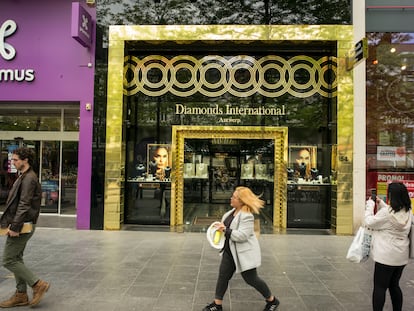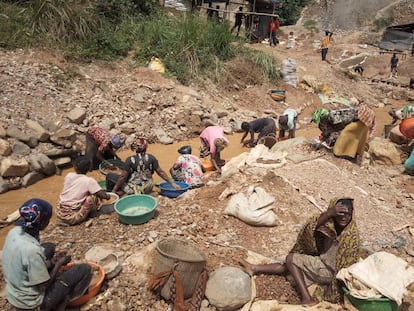Botswana’s diamond trade, an increasingly lucrative business in one of the most unequal nations
After years of negotiations, the country’s government has signed a new agreement with gem giant De Beers, which will give it a larger share of revenue

The push of the government of Botswana to obtain a greater share of revenue from the diamonds mined in its land and sold by the giant De Beers has paid off. After years of negotiations, the African country signed a renewed mining agreement this summer with the South African company, one of the largest diamond companies in the world, which will allow it to export a greater proportion of the precious stones. According to official data, just last year the business provided Botswana with revenues of $2.8 billion, a figure that is expected to increase with the new trade pact. However, this lucrative activity, thanks to which the country is no longer one of the poorest in the world, has not solved the serious problem of inequality that continues to afflict this southern African nation.
The negotiations over diamond trade and mining have been tense, with much at stake for both sides. Since the discovery of diamonds in the mines of Botswana in the 1960s – shortly after its independence from the United Kingdom in 1966 – the country has worked closely with De Beers to extract the rough diamonds through the joint venture Debswana, a collaboration that has proven to be very beneficial for both parties. On one hand, the South African mining giant depends on rough diamonds from the neighboring country for 70% of its trade; on the other, Botswana’s economy thrives thanks to the sale of the precious stones, which according to data from the International Monetary Fund, represent 90% of its exports.
At a community meeting held last May in a rural village, Botswana’s president, Mokgweetsi Masisi, said that his people “must refuse to be enslaved,” adding that he considered the then-current agreement with De Beers, signed in 2011, to be very restrictive. “We drew it at a time when we didn’t know much,” Masisi explained. “But our eyes have now been opened.”
For years, under the previous contract, the government of Botswana was only able to sell a small portion of the mined stones; the rest was managed by De Beers. That percentage was still 10% in 2010. However, under the new agreement, in the next decade it will gradually increase to 50%. The mining company will also invest $75 million in the diversification of Botswana’s economy, aiming to make it less dependent on diamond sales. This last point was essential for the Masisi administration, as Botswana (the world’s leading producer of diamonds by value) obtains 70% of its income from the gemstones, which means that the country’s economy is very vulnerable to the ups and downs in the world price of this product.
The repercussions of the war in Ukraine
Beyond the tough stance of Masisi’s government, experts maintain that the terms of the pact are also the result of the domino effect of the war in Ukraine. As a consequence of the sanctions against Russia, the world’s largest exporter of natural diamonds, Western buyers are now avoiding that country’s precious stones, as the veto that previously affected the so-called “blood diamonds” from conflict zones, now includes theirs, too, explains Benno Leeser, from the Dutch company Gassan. This has forced them to look for other suppliers. “Our customers, watch suppliers for example, are now asking us to state on our invoice that the diamonds do not come from Russia,” he says. This has turned Botswana into “the most important source of diamonds in the world,” states diamond expert Paul Zimnisky.
The rising demand for non-Russian diamonds, combined with the high prices, has benefited both De Beers and the government of Botswana: in 2022, the turnover of the Debswana joint venture amounted to $4.6 billion, compared to $3.5 billion the previous year. Thanks to these proceeds, Botswana recorded a budget surplus of 0.6% for the first time since 2016.
However, even though the World Bank has stated that the diamond trade has allowed Botswana to become an upper-middle-income country (in the 1960s, after its independence, it had almost no paved roads and there were only three high schools) the wealth has not reached the entire population; the same institution places it among the most unequal nations on the planet, only above eight other countries. A 2021 report from the United Nations Development Programme (UNDP) notes that the disparity between standards of living is very pronounced, and that urban areas consume 76% more than rural areas. In other words, people living in and around Gaborone, the capital, have much more money to spend.
The Botswana government’s demand to earn more from its own raw materials is part of a larger, continent-wide trend. For instance, last year, the government of Zimbabwe introduced new measures to prevent lithium exports in order to keep the transformation process within the borders of the country. In the Democratic Republic of the Congo, the government has also taken a tougher stance in the negotiations on cobalt exports. Namibia, which also collaborates with De Beers, although to a lesser extent, is considering “following in Botswana’s footsteps” and demanding a greater share of revenue from the diamond trade in the renegotiations of their agreements.
Sign up for our weekly newsletter to get more English-language news coverage from EL PAÍS USA Edition
Tu suscripción se está usando en otro dispositivo
¿Quieres añadir otro usuario a tu suscripción?
Si continúas leyendo en este dispositivo, no se podrá leer en el otro.
FlechaTu suscripción se está usando en otro dispositivo y solo puedes acceder a EL PAÍS desde un dispositivo a la vez.
Si quieres compartir tu cuenta, cambia tu suscripción a la modalidad Premium, así podrás añadir otro usuario. Cada uno accederá con su propia cuenta de email, lo que os permitirá personalizar vuestra experiencia en EL PAÍS.
¿Tienes una suscripción de empresa? Accede aquí para contratar más cuentas.
En el caso de no saber quién está usando tu cuenta, te recomendamos cambiar tu contraseña aquí.
Si decides continuar compartiendo tu cuenta, este mensaje se mostrará en tu dispositivo y en el de la otra persona que está usando tu cuenta de forma indefinida, afectando a tu experiencia de lectura. Puedes consultar aquí los términos y condiciones de la suscripción digital.
More information
Archived In
Últimas noticias
Most viewed
- Sinaloa Cartel war is taking its toll on Los Chapitos
- Oona Chaplin: ‘I told James Cameron that I was living in a treehouse and starting a permaculture project with a friend’
- Reinhard Genzel, Nobel laureate in physics: ‘One-minute videos will never give you the truth’
- Why the price of coffee has skyrocketed: from Brazilian plantations to specialty coffee houses
- Silver prices are going crazy: This is what’s fueling the rally










































